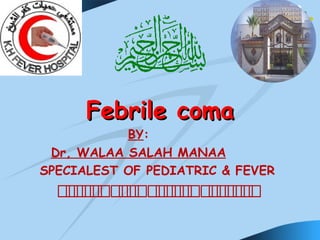This document discusses febrile coma, its causes, diagnosis, and management. It begins by defining coma and differentiating it from similar states like hysterical coma and syncope. The main causes of febrile coma are then outlined as CNS infections, cerebrovascular events, and infections/lesions elsewhere that can damage the CNS. The document emphasizes the importance of rapidly stabilizing patients and obtaining a thorough history and neurological exam. Key diagnostic tests are bloodwork, lumbar puncture if no contraindications, and CT scan if focal signs are present. Management involves treating any identified cause as well as empiric treatment of common infections if the cause is unknown. Proper diagnosis and management of fe

































































